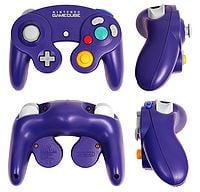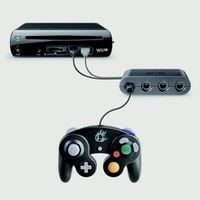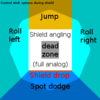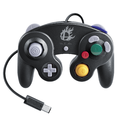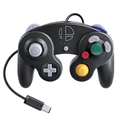GameCube controller: Difference between revisions
(→Standard controls: L and R buttons in SSBU are to grab, Z button in SSBU is for shield.) |
|||
| Line 30: | Line 30: | ||
|{{Button|GCN|Z|s=25px}}||[[Grab]] ([[Shield]] in ''Ultimate'') | |{{Button|GCN|Z|s=25px}}||[[Grab]] ([[Shield]] in ''Ultimate'') | ||
|- | |- | ||
|{{Button|GCN|L|s=25px}}{{Button|GCN|R|s=25px}}||[[Shield]] ([[Grab]] | |{{Button|GCN|L|s=25px}}{{Button|GCN|R|s=25px}}||[[Shield]] ([[Grab]] in ''Ultimate'') | ||
|- | |- | ||
|{{Button|GCN|D-Pad|s=25px}}||[[Taunt]] (up only in ''Melee'') | |{{Button|GCN|D-Pad|s=25px}}||[[Taunt]] (up only in ''Melee'') | ||
Revision as of 15:23, January 25, 2020
The Nintendo GameCube controller is the controller for the Nintendo GameCube. It is somewhat in the vein of the Nintendo 64 controller, but it lacks the middle grip.
The GameCube controller is used to play Super Smash Bros. Melee on the GameCube. The first retail version of Wii is also compatible with the GameCube controller, meaning that Super Smash Bros. Brawl can be played using a GameCube controller, and the Virtual Console release of Super Smash Bros. can also be played using the GameCube controller. Certain third-party GameCube controllers are not recognized by Brawl.
The Wii U is compatible with the GameCube controller through the use of an official adapter, however, it is only compatible with Super Smash Bros. for Wii U. Additionally, a GameCube controller was specifically made for SSB4, which is sold separately from the adapter unless a bundle is purchased.
The Family Edition and Wii Mini versions of the Wii do not utilise the GameCube controller as the hardware for backwards compatibility was removed. The GameCube controller option still appears in-game, since it's compatible with the software, but only the Wii Remote-based options are possible.
The GameCube is the most commonly used controller in competitive Smash, usually being used over the other options for Smash 64 and Brawl, for not only being the same as the Melee controller but for being wired (unlike all Wii Remote possibilities) and having an effective layout. Using the Raphnet Tech adaptor, it is possible to use the GameCube Controller for Smash 64, and any other N64 game.
GameCube Controller support is also available for Super Smash Bros. Ultimate. It requires the use of a USB Adapter in the same manner as Super Smash Bros. for Wii U. Nintendo is also selling a new adapter along with new GameCube controllers. Unlike the Wii U, however, the adapter also supports every game available on the Nintendo Switch (rather than exclusively Super Smash Bros. series games), albeit with some limitations due to the GameCube controller missing some buttons.
Standard controls
Super Smash Bros. Melee, Super Smash Bros. Brawl, Super Smash Bros. for Wii U, Super Smash Bros. Ultimate
| Move | |
| Standard attacks | |
| Special moves | |
| Stick-smash | |
| Jump | |
| Grab (Shield in Ultimate) | |
| Shield (Grab in Ultimate) | |
| Taunt (up only in Melee) | |
| Pause |
Super Smash Bros. (Virtual Console)
| Control | N64 equivalent | Action |
|---|---|---|
| Move | ||
| Standard attacks | ||
| Special moves | ||
| Jump | ||
| Grab | ||
| Shield | ||
| Taunt | ||
| Pause | ||
| Nothing | Move (menu only) |
Technical data
All buttons use rubber dome-switches, though L and R use a sliding potentiometer for analog control as well. Both analog sticks use potentiometers to measure the directional input.
Software
Shoulder buttons
The sliding potentiometers of the shoulder triggers use values from 0 to 255. Values from 0 to 73 take no in-game effect at all. In Melee, values from 74 to 174 scale inversely proportionally to shield size. Values of 174 and higher produce the same shield size as digital presses (all the way down through the click threshold), but only the digital press triggers techs and air dodges. In Brawl, only the digital press has any effect in gameplay, as every other controller option does not use analog input for their shoulder buttons. However, in Smash 4, the analog input now counts as a digital input, making the actual digital press of the shoulder buttons unnecessary. The analog input in Smash 4 works similarly to Melee, as there must be some distance travelled before the action mapped to L or R is recognized.
Analog sticks
Control stick and C-stick use two potentiometers that induce values from 0 to 255 with 128 being considered the center. An input of (0,0) would be diagonally down and left (225°). Values from 106 to 150 are generally considered neutral inputs and behave just like 128. In many player states, this range expands even further. For example, during the standing animation (WAIT), y (vertical) values from 73 to 180 take no effect, while at the same x (horizontal) uses the standard neutral range (106-150).
Hardware
Analog sticks
Control stick and C-stick make up the three most important parts: the stick itself, the stick box it is attached to, and the potentiometers the stick box is attached to. The shape of the stick box prevents the value extremes from being achieved, and the octagonal shape on the outer shell of the controller further cuts down the effective input range to approximately 25-230. This range varies from controller to controller and decreases with use as the friction between the inner stick box parts creates a gap and thus a loose zone. Because of this, a worn down controller's stick will push the potentiometer less than a fresh controller's stick.
Gallery
Trivia
- Super Smash Bros. for Nintendo 3DS is the only game in the series so far to not be natively compatible with the GameCube controller in any format. However, it is possible to modify the Nintendo 3DS to enable support for Nintendo GameCube controllers.[1][2][3]
References
- ^ http://kotaku.com/how-to-mod-your-3ds-to-play-smash-bros-with-a-gamecube-1643073790
- ^ http://www.eventhubs.com/news/2014/oct/08/play-super-smash-bros-3ds-gamecube-controller-open-source-mod-now-supports-c-stick-smash-attacks/
- ^ http://smashboards.com/threads/youtube-modder-loopy-creates-gamecube-adaptor-for-3ds.363834/
| Controllers and buttons | |
|---|---|
| Nintendo 64 controller | |
| GameCube controller | |
| Wii Remote (and Nunchuk) | |
| Classic Controller | L |
| Nintendo 3DS | |
| Wii U GamePad / Pro Controller | L |
| Joy-Con | |
| Switch Pro Controller | L |
| Third-party controllers | Hori Mini Pad · Arcade controller · Keyboard |
| Other | Smash Controller · Controller modification |
